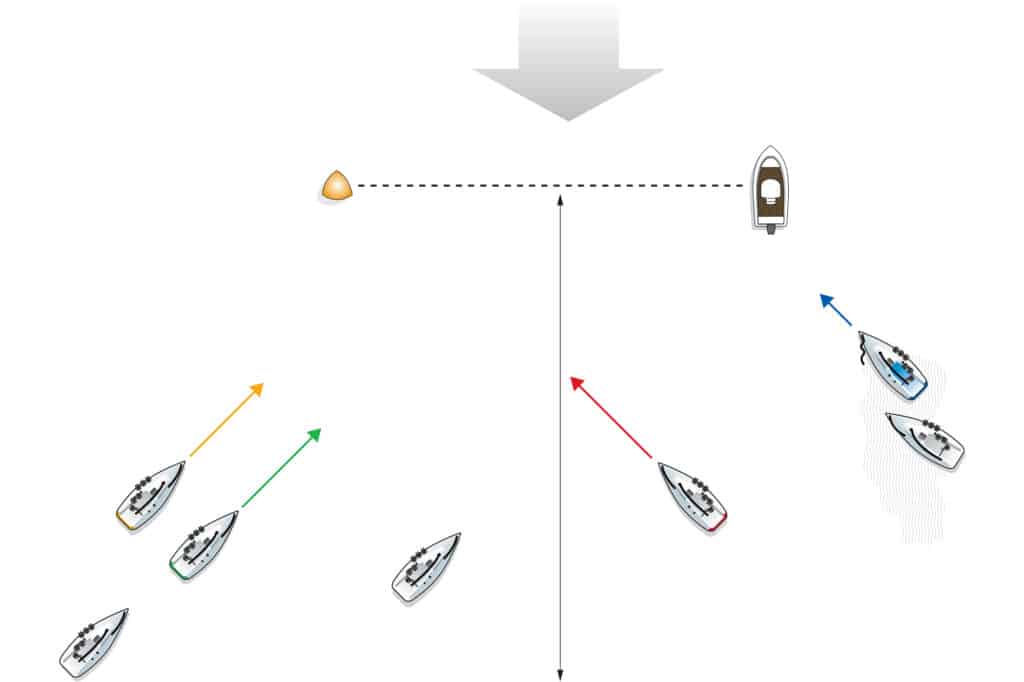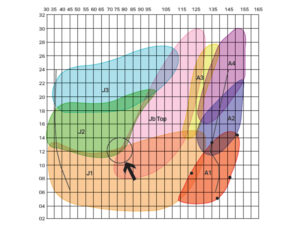
A big part of maintaining a lead is knowing your position in the event at all times, not just after you finish but during the race as well: If you are here, what does that mean? Or what do you have to do now, during this part of the race, to make the points more advantageous to you? The deeper into a regatta you are, the more important it is to know where you stand. Understanding the points after you finish won’t help much. By then, it’s a done deal. Once you know what the points are telling you, you can plan your race strategy accordingly; you’ll know when to sail conservatively or not, as well as which boats to cover, what kind of cover to use, and how to cover. Let’s look at what you can do over the course of a five-day regatta, such as your class championship or a major race week. If you’re racing in a shorter event, you can scale this approach accordingly.
Early Days: Easy Does It
Over the first two days, your goals should be to sail conservatively and achieve the best finishes possible without recording any bad finishes that will become throwouts. In a fleet of 40 boats, the goal is to be in the top nine the first day in both races and move into the top seven the second day in both races. For a three-day regatta, you’d be looking for these types of results in the first two races, or likely the first day of the regatta.
Work on doing well on the side of the course you chose to sail. If you’re in a good position, in the lead or close to it, encourage the boats around you to continue in the direction you want them to go, which often means pushing them out toward the layline. Don’t focus on specific boats. Think of the boats behind you as a group, and herd them; don’t tack on them. There’s an important difference. Herding gives them an avenue — meaning clear air or a clear path — to go in the direction you want them to go, which is usually the direction you’re going. You’re controlling them, but never getting in their way or being an obstacle to them. Whatever you do, don’t tack right on them. The last thing you want early in the regatta is to force them to split from you. Then all kinds of possibilities can enter the picture, and you’re no longer sailing conservatively.
When you get near the layline but are far from the mark, tack immediately below your competition rather than on them. By giving them a perceived lane just above you, you can ensure they won’t be encouraged to split and clear their air. Instead they’ll pinch to stay in that lane, and go slowly while you’re sailing your normal VMG. I learned this move from Dennis Conner maybe 20 years ago, sailing Etchells. He did it multiple times to me, and I always thought, “Why isn’t he tacking on me?” By the time we got to the mark, he would have gained four or five boatlengths. I suddenly realized: “Oh, that’s why. That works.” The boat behind naturally pinches to keep clear air and eventually loses.
Offensive Push Before Halftime
If you’ve sailed according to plan on the first two days and still don’t have a throwout, it’s time to be slightly less conservative. It’s still important to win your side, but you’re now looking for better results and can take more chances. You’ll be herding boats a little less and starting to hurt groups of boats by tacking on them. You won’t quite allow them the freedom you did over the first two days.
For example, let’s say you get to the layline and there are a few boats close to you. Tack on them and force them to tack away. Doing so will help guarantee that you beat them. Again, you’re still racing the fleet, not specific boats, so this strategy isn’t a radical departure from the first two days. You might occasionally tack on somebody close to you. If you’re confident about the way you’re going, you might do a little less herding and a little more pushing boats around by tacking on them. Assuming they want to go the direction you’re going, if you tack on them, they have to do two tacks to get clear of your wind shadow, and they might also have to sail a fair distance to find an open lane.

Target Your Bogies
Start examining the results and determining who is close to you. There might be four or five boats on your list. If you’re ninth or 10th in the regatta, the goal will be to get around the course in a way that produces the best possible results. If you’re in the top four or five, everybody in the top five should be on your list. It’s wise to also pay attention to anybody within eight to 10 points of you, regardless of where you are in the standings.
At this point, it’s imperative to have someone on your boat whose job is to keep track of the numbers. As the race progresses, that person can give you feedback about where you are relative to those boats while you concentrate on going fast and in the right direction. Don’t go out of your way to hurt a boat that will hurt you. However, if in the flow of a race you can push one of those boats back and not go back in the process, then do so. If people know how you sail, which is a goal in itself, you can also exert some control over them. Let’s say you’re all going out to a side, and the other boats know that if they’re in contention with you and they tack, you’re going to hit them. That alone lets you do some herding. They know you’re not going to let them past.
Control the Endgame
Your list of boats to manipulate is now smaller, probably consisting of around two or three boats. Now you start looking for those boats, going out of your way to slow them by tacking on them, which allows you to manipulate the points in your favor. Either you’re going to get it done on Day 5, or it’s not going to happen because you’re running out of races.
If the other boats split from you, you still have to go the way you think is best and punish the boats that go with you. Your game plan tells you the proper way to sail the racecourse. If you’re right about that in the first place, those who split from you are going the wrong way; if not, they’re going to beat you. It’s that simple.
When you tack on a team, be sure you’re tacking on their apparent wind, not their true wind. If you tack on their dead-downwind true-wind direction, they will have free air. Tacking on their apparent wind allows you to sail slightly faster than them and bow down a bit, giving them bad air and pushing them back. Herd them toward the layline whenever possible. Eventually they have to come back, and then you can sit on them all the way to the mark or the finish line.
If you get close to the finish in the final race and need to put boats between you and another boat, shift into team-racing mode. Oversheet the main and luff the jib, which is a basic team-racing move that creates a lot of turbulence, giving your competitors a real dose of bad air. It also broadens the cone of bad air a bit, making it tougher for them to escape. Of course, this will slow you down as well, so do this only in the last 200 yards or so, and judge it carefully. Ask yourself what you need to do, how many boats you need to put between you, and how long it will take. Know what you want to do before you do it.
In the end, a regatta is the accumulation of points. That’s all. Your points dictate your finish place, so make every point count. The goal is never to focus exclusively on winning races; it is to have the least amount of points at the end.









